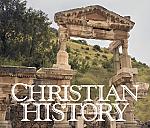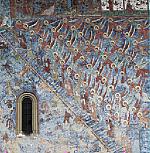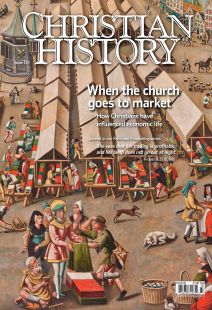Letters, Christian History 137
Snakes everywhere
In issue 135 at page 12 you mention a snake-encircled rod: “Asclepius, god of healing . . . was considered to be the son of Apollo. In this statue he holds his snake-encircled rod, which is still used as a medical symbol.” I was under the impression that the medical symbol of the erected snake-encircled rod was a reference to the Old Testament snake erected on a stake for the healing of the Israelites who, having fallen into sin, had been bitten by snakes, and to which Jesus points out in John 3:14–15.—George Day, London, England
The use of a snake-encircled rod to represent healing professions (either one snake for Asclepius or two snakes for Hermes) became popular in the eighteenth and nineteenth centuries; it was explicitly said at that time to be based on the Greek tradition (although obviously many Christians have connected it to the biblical story as well).
Not plagued by plagues after all
When I first received issue 135, I didn’t know whether to be glad that CHI decided to remind us of Christianity’s responses to pandemics and such in the past or whether to be irritated that here was one more source of information which was added to an already voluminous outpouring of data from all corners of the globe. . . .
While pondering on this choice, I actually set aside the magazine for a few days. This is very uncharacteristic of me since I normally devour CH as soon as I retrieve it from my mailbox. Eventually, curiosity reigned supreme. . . . Recognizing, after reading Bill Curtis’s “Editor’s note,” that this issue had been produced by people working at home during the lockdown, isolated from each other except by online media, yet faithfully turning out another CH magazine of the same substance and quality that readers have come to expect and respect, I was sorry that I hadn’t read it earlier.
I was especially appreciative of the reflections from various sources (p. 37–39) and Edwin Woodruff Tait’s concluding essay (pp. 40–41). The historical articles serve to remind us that truly “there is nothing new under the sun” (Eccl. 1:19). I pray that in some year, well into the future, CH will be able to assemble articles that highlight the efforts of the twenty-first-century servants of Christ who gave their all to help those in need during this COVID-19 pandemic. —Tom Edmunds, Washington, NJ
Gifts even in plague times
Your latest issue of Christian History was not only very timely, but extremely interesting and informative. I greatly enjoyed reading it. One comparison with history and the present-day COVID-19 pandemic is the almost total lack of our leaders calling for “seasons of humiliation and prayer” to God! It saddens me to see the apostasy of present-day America, and the secularization of the entire world. Thank you for your work in educating your readers.—Terry B. Franzine, Grand Rapids, MI
I don’t usually read CH from cover to cover, but I did this recent issue. . . . I found every article to be important, useful, and interesting, but [Dan Graves’s] summary was most valuable: As God has gifted each of us. Thank you for such a thoughtful conclusion. It confirmed the current decisions my husband and I are living (ages 84 and 82).—Sharon Bridges, Kingwood, TX
A lot of people must have worked very hard on [CH 135] to have it put together and out so quickly after COVID-19 spread. I certainly learned a lot and will have it for reference. I hadn’t realized how many plagues and epidemics there had been over the years. Having worked in the medical field for a long time, I found it particularly interesting.—Mary Martin, Burnaby, BC, Canada
My husband subscribes to Christian History (almost 40 years) and enjoys it immensely. I was just reading issue 135 and ran across an article by Gary B. Ferngren called, “Demonstrating the love of Christ.” It succinctly summarizes what my husband and I have told people for years, how Christians demonstrated the love of Christ in such a powerful way during times of plague and epidemic, that the world was changed, and “health care for all” was born. . . . Please tell Dr. Ferngren we really like his article! I can’t wait to read the rest of the magazine!—Laverne Larson, Wausau, WI
We passed on your compliments, and Dr. Ferngren was thrilled.
Students of Christian history
I am a long-term teacher at our church. Christian History has been very helpful to me over the years in preparing lessons and for enrichment of my general understanding of many dimensions of Christianity. The material is concise, yet provides sufficient context for accurate understanding. May God continue to bless your efforts.—Richard Brown, Huntsville, AL
I have been receiving your magazine over the years—from at least the 1990’s. . . . It is always thoughtful, well presented, and researched, and I have used it as a resource for adult faith learning and sermons. It’s a pity more Australian Christians aren’t particularly interested in the many stories of Christianity. . . . If you would like a suggestion for a future issue why not tackle Liberal Christianity as a response to a changing world?—David Carter, Victoria, Australia
We always love to hear how our material is being used in churches! You might want to take a look at issue #129, “Recovery from Modern Amnesia,” which addresses the issue of modern theology.
Stories still untold
I was introduced [to CH] in the 1990s and still enjoy reading all my issues, however I would love to see an issue dedicated to the challenges and victories of God’s Children of Ebony, like Amanda Berry Smith . . . William Seymour for his work with the Azusa Street Revival, and so many others. . . . I do not understand how this magazine has missed the many African and saints of color whom God had and is still commissioning for His Great Commission.—Leona Baylor, Mechanicsville, VA
While we have published some issues dealing with African Christianity and African American Christianity (see especially #58, #62, #79, and #105), we are committed to doing better in this regard as we seek to cover all aspects of Christian history.
A mustard seed
We have been very blessed by your magazine editions, old and new ones. So we are sending you our little mustard seed that we hope the Lord multiplies in your hands. May the Lord bless you and give you the strength to continue publishing this great magazine to spread the Good News and to show the history of Christianity to God’s People. . . .
P.S. Being a Hispanic, I was very impressed and blessed by your issues #130 Latin American Christianity and #35 Columbus and Christianity—Carlos Avelar, Lansing, MI
Meet the staff: MEG MOSS
How long have you been at CHI and what is your role?
My work as a freelance proofreader for CH started with the special “History of Worship” guide published in 2012. After all the articles have been written and edited, my job is to wrangle any wayward grammar, unruly punctuation, and lingering typos.
What is your favorite part of the job?
I’ve spent much of my freelance career on the editorial end of history projects: museum exhibits, history journals and magazines, corporate histories, and so on. I love engaging that interest with CH to deepen my understanding of my own faith. Each issue introduces me to more fascinating people doing God’s work. Just when I thought I’d met my favorite, along comes Hildegard of Bingen or E. Stanley Jones. Every issue surpasses the last with amazing accounts of faith, servanthood, and wisdom.
What do you most wish readers knew?
I’m guessing the quality of each issue tells readers of the dedication and expertise of our team of writers, editors, researchers, and designers, but I’d like to confirm that. Especially as an outside contractor who has worked with many magazine clients, I am here to tell you that the team behind Christian History is second to none.
What do you do in your spare time?
Ha, what’s that? I mostly enjoy the surroundings of our hobby farm in Indiana from my office window and hanging out with my grandkids who live next door. And before the COVID era, I loved singing with the local Philharmonic Chorus and my church choir. I’m a dabbler in many things—spinning, crocheting, cooking, gardening—but not really very good at any of them. My proudest “spare time” accomplishment is sailing 15 Chicago to Mackinac Island races up the length of Lake Michigan. Each one was a breathtaking experience. CH
By Readers and the editors
[Christian History originally published this article in Christian History Issue #137 in 2020]
Next articles
Editor's Note: When the church went to market
What should be the relationship of Christians to economics and the market?
Jennifer Woodruff TaitThe undeserving poor
Early Christians emphasized doing good for all, whether or not they were worthy
Daniel F. CanerSupport us
Christian History Institute (CHI) is a non-profit Pennsylvania corporation founded in 1982. Your donations support the continuation of this ministry
Donate






